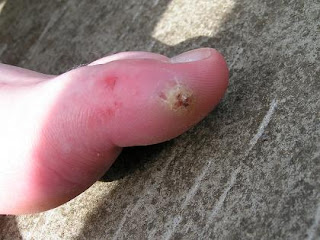 Plantar warts are warts of the feet. They can make walking very painful. As this cuts down on the amount of exercise a person gets, it can contribute to an overall decline in health. It is necessary to treat plantar warts, and sometimes you can do it at home.
Plantar warts are warts of the feet. They can make walking very painful. As this cuts down on the amount of exercise a person gets, it can contribute to an overall decline in health. It is necessary to treat plantar warts, and sometimes you can do it at home.First of all, many people with plantar warts also have diabetes. If this is the case, you should always seek professional consultation. People with diabetes can’t afford to take chances with their feet because of their particular health issues.
If you don’t have diabetes, though, you may be able to do something about your plantar warts at home. Just as with common warts, you can use salicylic acid liquids such as Dr. Scholl’s or medicated pads such as Mediplast.
With a plantar wart, it is especially important to protect the area surrounding the plantar wart. You may put a lot of weight on the wart. Any acid you put on healthy skin will soak in and eat away a circle of skin around the wart. To avoid this, you can put petroleum jelly around the circumference of the wart.
Keeping a plantar wart dry is crucial helping it to go away. Try putting on a drying medicated powder up to ten times a day. Change your socks at least three times a day. Some people have even used chlorine to thoroughly dry their feet. If the plantar wart is faithfully kept clean and dry, it doesn’t stand a chance.
On the other hand, some people recommend methods that keep moisture on the wart. As little as this makes sense given that warts thrive on moisture, some find these methods effective.
A remedy that is often referred to is the banana peel remedy. You tape the inner side of a banana peel down onto a plantar wart. This is supposed to draw out the wart. Some say it works well.
One method is to slice up lemons and use them in a remedy. Put them in apple cider and let them ferment for a couple of weeks. At the end of this time, rub the lemon slices on your plantar warts.
You can get Vitamin C tablets at a supermarket, health food store, or pharmacy. Crush tablets of it and apply it to the plantar wart. Cover it with a bandage. Again, bandages are usually not recommended by the experts because they hold in moisture. Moisture does nothing to help remove plantar warts, or any warts.
Another such treatment is applying grapefruit extract to the plantar wart a few times a day. Once more, the suggested treatment is to cover it with a bandage. If you do, make sure that you take the bandage off whenever you can. Let the area air out and dry up a bit.
Aside from genital warts, plantar warts probably require the most attention. Because they cause pain in the feet, they cut down on a person’s mobility. If you have diabetes, you need a physician’s help. If you can treat plantar warts, that’s great. If you can’t, go on to the doctor.
Beware The Laser Treatment

Do You Have Courage To Do This?
Dreamhost rebate



